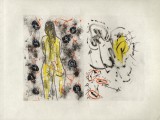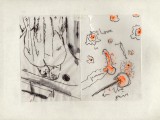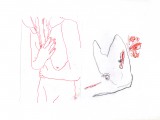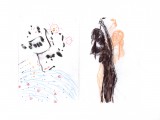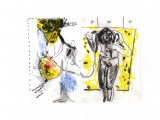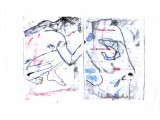Speech spoken at the Opening of the Exhibition in Gallery Kokon, Tilburg, the Netherlands ( 25 april 2004) by Dr. Jos Wilbrink, Director of The Centre for Art in Brabant.
“The title of this exhibition ‘to wash my life’ speaks volumes in a literal as well as in a figurative sense. It has been composed from a large number of leaves from sketch books that Li Koelan has filled with hundreds of drawings in recent years. Moreover a real book, bearing the same title, is to appear of this selection.
Texts and letters play a great part in it. It’s all about the concepts of life (with an f) and live (with a v) ’To wash my life’ is about coming to terms with oneself, about washing a piece of your life, about being able to go on; about living your own life, so to speak.
The v (vrouw, which is the Dutch word for woman) as well as the f (female) point to being a woman, the central theme in Li’s work. Or is that just coincidence?
‘To wash my life’ is about washing as a ritual pursuit of which the meaning goes further than only the cleansing of the body. Ritual cleansings are of all times and occur in all cultures.
The immediate cause of this series of drawings was the end of a love affair that had lasted for a long time. A situation that gave rise to a lot of grief and a lot of questions. Questions about herself, about this part of her life, about this part of her life in relation to the rest of her life, about her life in relation to the world around her, about her life in relation to life in general.
The experience of being left to one’s own devices again necessitates a process of adaptation requiring lots of energy and especially lots of time. The first phase one goes through is loosening oneself from what has happened to you. That means that you have to map out what you are feeling and consequently you have to give that a place in the world of your experience. Stuck away there it soothes the pain and you find back your independence. You can move on.
That doesn’t only apply to women, but to men as well. It is not unique. It occurs in every life. Sometimes more than once and in several grades of vehemence.
Which is unique however, is that Li has used her talents as an artist to run through this process. By making drawings on a daily basis she succeeded at last to rise up from misery. The drawings presented themselves, even forced themselves on to her every day from her sub conscience, in brief violent moments, discharging in line, shape, colour and text.
The drawings always consist of two apparently opposite images. An abstract half with a chaotic character and a figurative half with a more narrative character. Yet they are not images that are complementary to each other such as beautiful and ugly, happiness and sadness. Much more the chaotic and the figurative represent two consecutive phases of the same process. Total desperation with no way out (chaos) is followed by an image in which desperation has assumed form (the figurative). That transition is essential. The process of assimilation becomes visible in the anecdotal and literary part of the image.
The washing of the body is a recurring theme. Especially the washing of her hair. She look upon washing hair as typically feminine. Furthermore that was part of her daily routine, often more than once a day.
The fact that the cleansing ritual was made into a theme, points out how hard it must have been. It points out how destructive this external force has been, a force that at first you do not want to admit, but which you cannot avoid in the end. A situation that you didn’t want but which forces itself on you and that, once it has become the master of your person, leaves its indelible marks on you. It is present in every nook of your body.
You know this from the way Li portrays herself. Sometimes the body is filled up with little lines, sometimes the body gets a supporting colour to point out clearly what takes place inside.
This can also be seen from the numerous questions and remarks which are present as moments of text in the image. ‘I loved just like a woman’ ‘what is this?’ ‘who am I?’ ‘Love pain is in the air.’
We see arrows pointing to painful places. Dotted lines that suggest scars, or that divide the body into parts.
Ladies and Gentlemen, have a close look. Her face is never visible. That tells you everything. It is self-evident.
At first she is having a conversation with herself. A sort of internal dialogue between the present and the recent past in which every drawing represents the question as well as the answer. Thus, drawing after drawing, the entire story is told, assimilated and elucidated. Li does this openly, convinced as she is that it will generate the power she will need to go on.
In contrast with her earlier work, which is all about being a woman, this work illustrates a period of re-orientation that every woman probably goes through in her lifetime. During which you look inside for what is left of your own self and how you can activate that as a buoying force in your existence.
There are more artists that focus on their private lives, but it’s not the same thing. The best known of them is Tracey Emin, who open-heartedly embroiders personal experiences from her youth, as well as sexual experiences, in performances, video works, textile & text works, neons, drawings and photos.
I also see a connection with the work of Elke Krystufek, a Viennese artist who, through her work, wants to liberate herself from her own restrictions and from the shackles of roll models, values and expectations dictated by society. She constantly crosses the border between the private and the public domain with photos and pictures of herself. I have no privacy, she says, everything is public.
In its motif this exhibition is germane to that. It denotes a fight against the evil that came from outside, but at the same time against the disastrous feelings that came from within. Al in the form of disbelief and desperation a fear of desertion. But also in the form of double images that kept showing different female images of herself. It seems, Li says, that I had to repeat and meet again my memories, happenings, the fear of desertion, pain, sorrow, fury, panic, impotence, hysteria, for a million times over and over again, until I really remembered who I was and who I am….
In another series of drawings the phrase ‘Reincarnation des Bewustseins’ keeps cropping up. She came face to face with the experience that she had forgotten part of her own life. She had to retrieve her powers. Come into contact with the world again, find the space to be really free again.
That has been an awkward process. You can see it from the drawings. You feel the closeness of a bathroom. The body is represented in different ways all the time. Sometimes sturdy and powerful as a reference to new energy but falling back again into the primeval soup of pain. ‘Perhaps tomorrow’ we read in drawing nr. 63
The black arm on the red body in drawing nr. 70 indicates in a poetic way how she draws history away with the help of her left hand.
In the last part the drawings become more picturesque and a vital blue appears, as we know it from Yves Klein.‘to wash my life’ has returned that force of life.
Li Koelan changes the strangulation of one cocoon for the free space of another one. The way in which the work is shown proves this. The evil has been contained for ever, maybe in the aluminium houses.
The drawings have been hung in an uninterrupted series on the virgin white of the gallery. They form a closed circle. What we see here refers, starting today, to the self, to a story that has been overtaken by time. ‘Das war es’ we read in drawing 111. ‘To wash my life’ has become a statement that is transferred to publicity. The force is hanging on the wall.
Li Koelan is facing you again.
Ladies and Gentlemen,
We witness a moment at which the significance of the drawings of Li Koelan is transformed to a higher and more universal level. The moment at which therapeutic self-reflection finally turns into plastic art.
The questions are now posed to you.
Whoever wants to experience ‘to wash my life’ as intensely as Li herself must look closely or, better still, take part of the series home. When everything is sold the circle dissolves and the story finds its way into many other lives. The cycle is complete.
What presented itself as a terrible end proves to be a good beginning.
Defeat was transformed into victory.
A victory that will eternally live on in the drawings.
Li, c’est la vie, with a v “


